
 TUTORIAL: SIGNS AND LANGUAGE
TUTORIAL: SIGNS AND LANGUAGEINTRODUCTION . ICON, INDEX AND SYMBOL . THE SEMIOTIC MODEL . DENOTATION AND CONNOTATION . PARADIGM AND SYNTAGM . ABSTRACTION . METAPHOR . METONYMY . MYTH
We use certain "signs" among ourselves that do not point
to anything in our actual surroundings. Instead of announcers of things,
they are reminders ... they take the place of things that we have perceived
in the past, or even things that we can merely imagine by combining memories,
things that might be in the past or future experience. They serve
to let us develop a characteristic attitude toward objects in absentia,
which is called "thinking of" or "referring to" what is not here. --Suzzane Langer
![]() 1016
1016
Human beings possess the ability to notice patterns in their environments. When the perception of these patterns leads to the interpretation of new information in the context of previous knowledge, we might say that meaning occurs. The notion of meaning, or the making sense out of one's information, is an important aspect of human communication.
There is little agreement as to how the term "meaning" should be defined, nor is there agreement as to how meaning is created, preserved and destroyed in the midst of the communication process. However, attempts to reconcile these disagreements have led to the development of a number of differing points-of-view. Important among these are the following:
Such a statement as "The word 'cat' stand for a certain small mammal" is not either true or false. Its truth depends upon agreement between the speakers that it be true. In terms of such agreement they understand each other; or where disagreement occurs they will meet with misunderstanding. --Gregory Bateson
A sign is a pattern of data which, when perceived, brings to mind something other than itself.
Although this definition appears simple on the surface, it has complex implications. Please pause to look at Figure 1 for a moment or two.
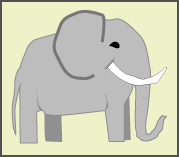
Now, briefly, and to yourself describe the thoughts that Figure 1 brought to your mind. It may help if you write these down.
...........waiting............. ... please look at the picture and form your
thoughts before you continue ... ..................................
This situation illustrates the three fundamental building blocks which, together with the rules that describe how they relate to one another, will be used to construct the Semiotic Model of Communication.
At the beginning of the exercise, did this sign: ![]() , bring to mind a large,
African or Indian animal? Or memories of a trip to the zoo? Or images
recalled from a favorite book read as a child, or a television show, or a
movie...? Perhaps it brings to mind an American political party; or perhaps
the notion of memory (as in: "a large animal with a trunk and big ears that
never forgets ...").
Notice that whatever the sign brings to mind, the concept is related to the
reader's past experience with the object.
, bring to mind a large,
African or Indian animal? Or memories of a trip to the zoo? Or images
recalled from a favorite book read as a child, or a television show, or a
movie...? Perhaps it brings to mind an American political party; or perhaps
the notion of memory (as in: "a large animal with a trunk and big ears that
never forgets ...").
Notice that whatever the sign brings to mind, the concept is related to the
reader's past experience with the object.
This is always the case with signs, and one of the advantages of the semiotic model lies in its ability to highlight relationships among the sign, the concepts the sign brings to mind and the experience of the reader. The next picture illustrates this relationship.
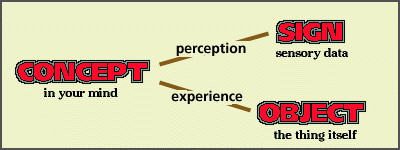
It might be that one day during a trip to the zoo, the reader saw a large animal -- and so later when he or she sees a printed image that resembles the animal, that earlier experience is brought to mind.
Connection-by-resemblance is one of the three fundamental ways that
signs, concepts and experiences relate. This particular kind of sign is called
an icon. If a sign is a perception that refers to,
or brings to mind,
something other than itself, an icon is a type of sign that resembles the
thing that it refers to.
Thus, ![]() is an icon because it resembles
the animal that it brings to mind.
is an icon because it resembles
the animal that it brings to mind.
![]() 1020
1020
You may have noticed that in our discussion of ![]() , we have carefully refrained
from using the word elephant. The reason for this is that the word
#elephant# is itself a sign, though a different kind of sign than
, we have carefully refrained
from using the word elephant. The reason for this is that the word
#elephant# is itself a sign, though a different kind of sign than ![]() .
.
Note: what do the #s mean in the last paragraph?
This second type of sign is called a symbol. Symbols and the objects that they bring to mind are related in an arbitrary manner. This means that there is no known reason why the symbol and the object are related. For example, there is no reason why the large animal under discussion might not be tagged by a different word -- #nordnet#, for example, or #frindlemat#, or perhaps #barracuda#. #Elephant# is used simply because over the years, it has come to be used -- no one knows why.
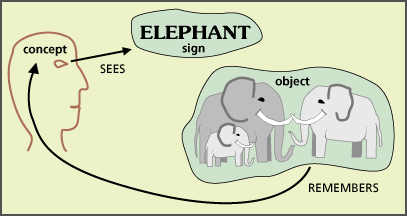
A third kind of sign brings a concept to mind by means of a direct, physical connection between itself and its object. For example, if someone is walking down a street and suddenly encounters the smell of freshly baking bread, he or she might find the concept of a bakery coming to mind. This kind of sign is called an index.
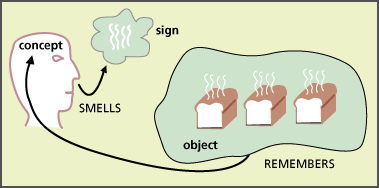
To summarize -- there are three basic types of signs: the icon, the index, and the symbol. Each brings to mind concepts that are related to the perceiver's previous experience with objects in the world. Each operates in a different way:
Icon -- a sign that resembles its object
![]()
If this brings to mind a kind of fruit, it is acting as an icon. ![]() 1006
1006
Index -- a sign that is physically connected to its object
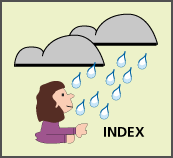
If the rain touching your face brings to mind the nearby storm, it is acting
as an index. ![]() 1005
1005
Symbol -- a sign whose relationship to its object is arbitrary
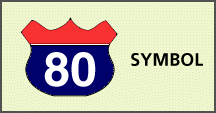
If this brings to mind an interstate highway in the United States, it is acting as a symbol.
![]() icon
icon
![]() symbol
symbol
![]() index
index
![]() 1007
1007
![]() 1008
1008
![]() 1009
1009
![]() 1019
1019
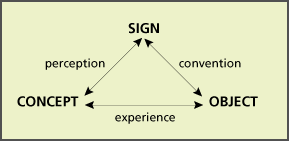
This version of the semiotic model is adapted from the work of the American philosopher Charles S. Pierce. Pierce is generally acknowledged as an important pioneer in the study of signs.
Notice that
These connections are important to the study of how meaning arises during the daily encounters with the many signs that fill the human environment. The remaining sections of this tutorial investigate some of the ways that meaning arises as people make use of signs during the process of communication.